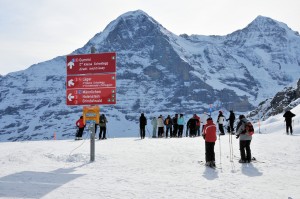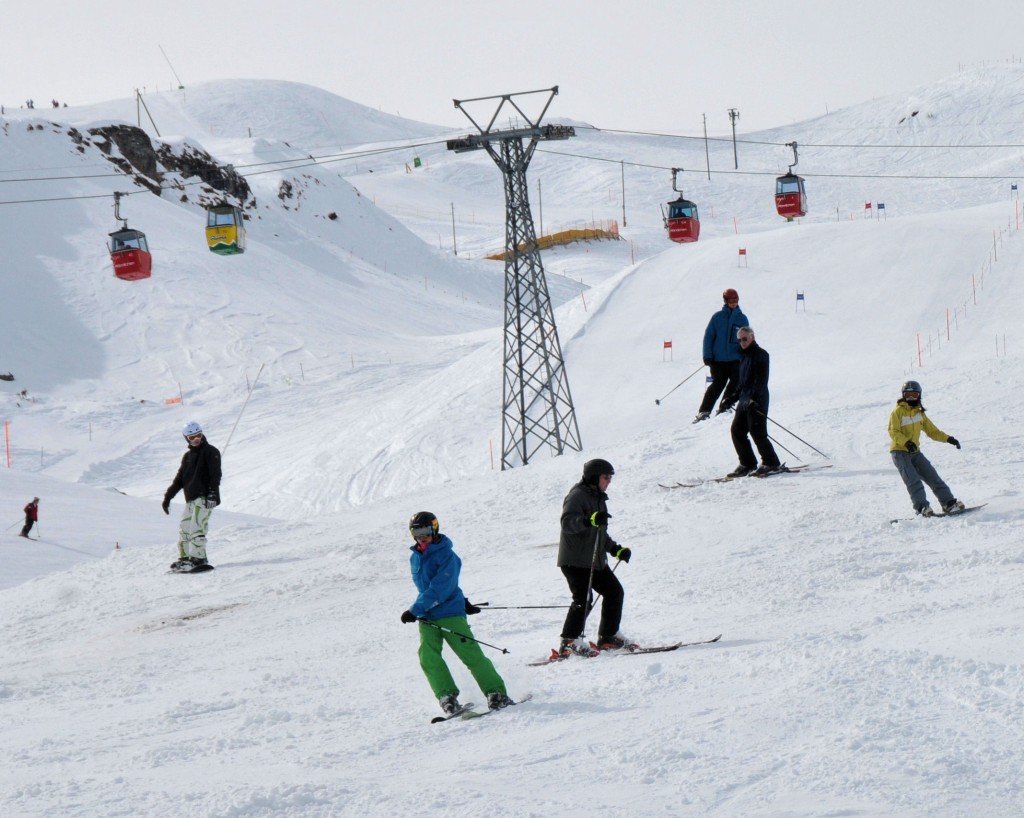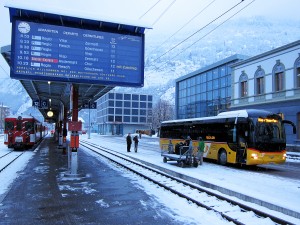Basel is a great base for skiing and snowboarding Switzerland. If you live in Basel or are visiting, you can benefit from being in Switzerland’s premier transport hub. If you are staying, there are plenty of accommodation options with a very affordable and convenient YMCA and a clutch of mid-priced hotels near the station. If you are coming in for a break from abroad, Basel’s International Airport and SNCF terminus are the closest entry point for North and North-West Europe.
Using an SBB (Swiss Rail) Snow’n’Rail pass you get significantly discounted rail, bus, cable car and ski passes to all of the major winter sports resorts in Switzerland. The tickets are available from both ticket offices (which open at 6am) and automated ticket machines (which work in English), and you have a number of options for spending between 1 and 6 days on the slopes. When you buy your ticket, however, do make sure you select the right destination and right package. I have made some recommendations on which place to alight for the slopes below. In terms of packages, do bear in mind that some ski areas can provide cheaper, more limited ski passes – or may even provide a more limited one at the lift station on the assumption you won’t ski the whole area. For Verbier you may find your pass doesn’t give you access to Mont Fort without paying a supplement, and for Saas-Fee you should ensure you receive a full Saastal pass to enjoy some of the unexpectedly enjoyable skiing at Saas-Grund and Saas-Almagell.
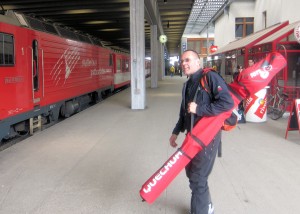 Below are typical journey times to many of the resorts and the typical number of changes you need to make. I’ve skiied all the resorts on this list using Snow’n’Rail and only once failed to make a connection. With an early start and with a couple of exceptions, you can be on the pistes around 9-10am. Engelberg is probably the easiest, but has the tightest connection, so don’t linger in Luzern station unless you want to take a later connection. Although the main lifts at Engelberg are walkable from the station, you are better off taking the complementary ski bus. The main centres of the Bernese Oberland (Grindelwald, Wenger, Murren, Zweisimmen and Adelboden) are relatively easy to get to from Basel, and all have good integration between the rail, bus and lift networks, i.e. very little walking. From Bern they are all an hour closer, as are many of the resorts in Valais.
Below are typical journey times to many of the resorts and the typical number of changes you need to make. I’ve skiied all the resorts on this list using Snow’n’Rail and only once failed to make a connection. With an early start and with a couple of exceptions, you can be on the pistes around 9-10am. Engelberg is probably the easiest, but has the tightest connection, so don’t linger in Luzern station unless you want to take a later connection. Although the main lifts at Engelberg are walkable from the station, you are better off taking the complementary ski bus. The main centres of the Bernese Oberland (Grindelwald, Wenger, Murren, Zweisimmen and Adelboden) are relatively easy to get to from Basel, and all have good integration between the rail, bus and lift networks, i.e. very little walking. From Bern they are all an hour closer, as are many of the resorts in Valais.
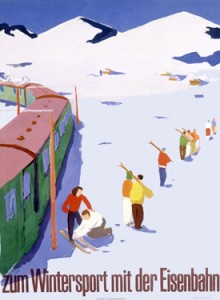 Many of the resorts of Valais and Graubünden are realistic options for a day trip. Zermatt, Saas-Fee, Aletsch, Flims, Klosters, Lenzerheide and Arosa all justify the effort and have lifts very near to the train station or a bus stop. Davos is also a do-able day destination, but it is more convenient to go to Klosters for the Parsenn, with its lifts adjacent to the station.
Many of the resorts of Valais and Graubünden are realistic options for a day trip. Zermatt, Saas-Fee, Aletsch, Flims, Klosters, Lenzerheide and Arosa all justify the effort and have lifts very near to the train station or a bus stop. Davos is also a do-able day destination, but it is more convenient to go to Klosters for the Parsenn, with its lifts adjacent to the station.
Flumserberg is popular from Zurich, but is also a pleasant excursion from Basel. For all the resorts in Graubünden and Eastern Switzerland, Zurich makes a better starting point than Basel, shaving at least an hour off the journey time.
To ski St Moritz you realistically need to stay overnight if you want to get a full day of skiing, and if you intend to do the Engadin justice you should get a two day pass and stay over two nights so you can get to both Corvatsch and Diavolezza. Samnaun is also not a realistic option from Basel for the day, with over a 5 hour journey time, and if you want to ski Samnaun you’re probably better off staying at Ischgl in Austria.
Les Portes du Soleil and the Vaud Alpine resorts of Leysin, Les Diablerets and Villars look a bit of a stretch for a day trip from Basel, but I’ve done these trips and found them worth the effort. Lausanne is a better base to ski or snowboard Francophone Switzerland (Romandie), generally saving at least a couple of hours on the journey.
Airolo in Italian-speaking Ticino is the only ski resort you can get to directly from Basel without a change, bizarrely. Incidentally the nearest ski and snowboarding to Basel is actually in Baselland, at Langenbruck, an hour by public transport from Basel. Although nothing to set the pulse racing, if the conditions are right it is fine for intermediates looking to get in a bit of practice. Better skiing and snowboarding is across the border in the Black Forest, where Feldberg offer surprisingly varied pistes and a good lift system. Feldberg can be reached by public transport or by car from Basel, although get there early if you want to park anywhere near the lifts!
Some of the resorts (denoted with an asterisk below) require you to take a bus for the last leg of the journey. Don’t let this put you off! The buses are every bit as reliable as the trains, integrate well with the train network, have facilities to take skis and snowboards and are at least as likely to drop you off at the lift station as trains do. Most of the buses are operated by the Postbus network with their distinctive yellow livery, but there are a number of other companies that also operate buses which participate in the Snow’n’Rail scheme. Buses can also be useful if you take an off-piste itinerary that drops you down to somewhere different from where you started. As often as possible in the text of articles on resorts I’ll let you know where these stops are.
| Resort |
Recommended Station/Stop* |
From Basel |
Time |
Changes |
| Adelboden-Lenk |
Adelboden, Mineralquelle* |
Bern / Frutigen |
2.35 |
2 |
| Airolo |
Airolo |
|
2.57 |
0 |
| Aletsch |
Betten |
Bern / Brig |
2.38 |
2 |
| Alpes Vaudoises |
Les Diablerets |
Lausanne / Aigle |
3.47 |
3 |
| Arosa |
Arosa |
Chur |
3.36 |
1 |
| Crans-Montana |
Montana Gare / CMA* |
Bern / Visp / Sierre |
3.07 |
2 |
| Davos |
Davos Platz or Dorf |
Landquart |
3.22 |
1 |
| Engelberg-Titlis |
Engelberg |
Luzern |
2.09 |
1 |
| Flims / Laax / Falera |
Flims Dorf, Bergbahnen* |
Chur |
2.48 |
1 |
| Flumserberg |
Unterterzen |
Zurich / Ziegelbrucke |
2.29 |
1 |
| Grindelwald |
Grindelwald |
Interlaken Ost |
2.38 |
1 |
| Gstaad Mountain Rides |
Zweisimmen |
Bern |
2.19 |
1 |
| Klewenalp |
Beckenried, Post* |
Luzern / Stans |
1.58 |
2 |
| Klosters/Davos |
Klosters |
Landquart |
2.52 |
1 |
| Lauchernalp / Lotschental |
Wiler, Seilbahn* |
Bern / Spiez / Goppenstein |
2.47 |
2 |
| Lenzerheide |
Canols, Rothornbahn* |
Chur |
3.06 |
1 |
| Les Portes du Soleil |
Champèry |
Lausanne / Aigle |
3.57 |
3 |
| Meiringen / Hasliberg |
Meiringen |
Interlaken Ost or Luzern |
2.34 |
1 |
| Murren |
Murren |
Interlaken Ost / Laterbrunnen |
2.14 |
1 |
| Obertoggenburg |
Wildhaus, Post* |
Zurich / Buchs |
3.02 |
2 |
| Saas-Fee |
Saas-Fee, Busterminal* |
Bern / Visp |
3.01 |
1 |
| St Moritz |
St Moritz Bad SMBB* |
Chur |
4.25 |
1 |
| Verbier |
Le Chable |
Bern / Visp / Martigny |
3.38 |
3 |
| Wengen |
Wengen |
Interlaken Ost, Lauterbrunnen |
2.14 |
1 |
| Zermatt/Cervinia |
Zermatt |
Visp |
3.24 |
1 |
The SBB Railaway Snow’n’Rail web site is seasonal, but you should be able to find an overview of the product and links to resort details here. Although much of the information is in English, more resorts are covered in German. Check routing information at the Swiss Rail website – at times you may need fewer or more changes than indicated above for fastest transfers, and for Valais and Vaud resorts there may be other routing options.


